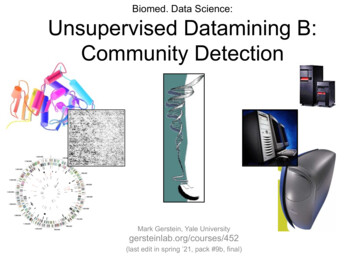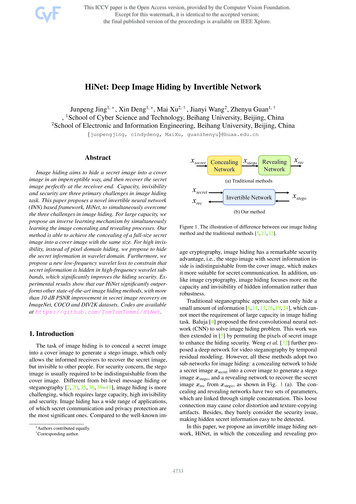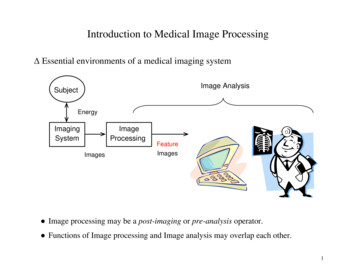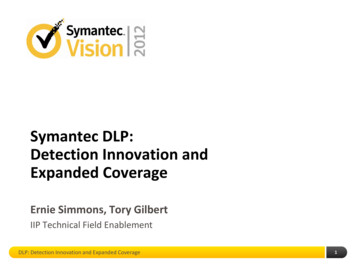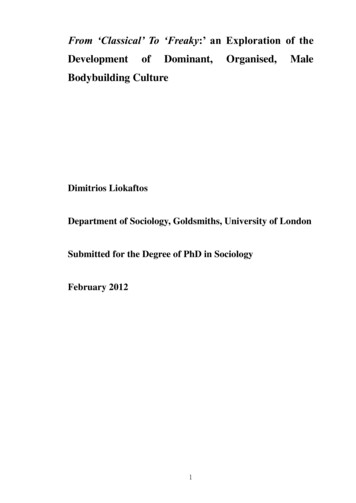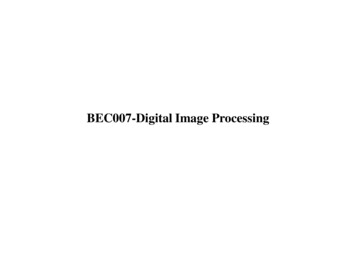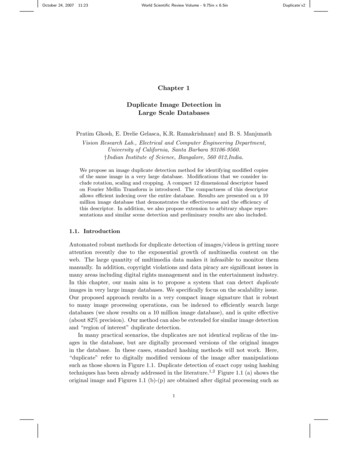
Transcription
October 24, 200711:23World Scientific Review Volume - 9.75in x 6.5inChapter 1Duplicate Image Detection inLarge Scale DatabasesPratim Ghosh, E. Drelie Gelasca, K.R. Ramakrishnan† and B. S. ManjunathVision Research Lab., Electrical and Computer Engineering Department,University of California, Santa Barbara 93106-9560.†Indian Institute of Science, Bangalore, 560 012,India.We propose an image duplicate detection method for identifying modified copiesof the same image in a very large database. Modifications that we consider include rotation, scaling and cropping. A compact 12 dimensional descriptor basedon Fourier Mellin Transform is introduced. The compactness of this descriptorallows efficient indexing over the entire database. Results are presented on a 10million image database that demonstrates the effectiveness and the efficiency ofthis descriptor. In addition, we also propose extension to arbitrary shape representations and similar scene detection and preliminary results are also included.1.1. IntroductionAutomated robust methods for duplicate detection of images/videos is getting moreattention recently due to the exponential growth of multimedia content on theweb. The large quantity of multimedia data makes it infeasible to monitor themmanually. In addition, copyright violations and data piracy are significant issues inmany areas including digital rights management and in the entertainment industry.In this chapter, our main aim is to propose a system that can detect duplicateimages in very large image databases. We specifically focus on the scalability issue.Our proposed approach results in a very compact image signature that is robustto many image processing operations, can be indexed to efficiently search largedatabases (we show results on a 10 million image database), and is quite effective(about 82% precision). Our method can also be extended for similar image detectionand “region of interest” duplicate detection.In many practical scenarios, the duplicates are not identical replicas of the images in the database, but are digitally processed versions of the original imagesin the database. In these cases, standard hashing methods will not work. Here,“duplicate” refer to digitally modified versions of the image after manipulationssuch as those shown in Figure 1.1. Duplicate detection of exact copy using hashingtechniques has been already addressed in the literature.1,2 Figure 1.1 (a) shows theoriginal image and Figures 1.1 (b)-(p) are obtained after digital processing such as1Duplicate v2
October 24, 200711:232World Scientific Review Volume - 9.75in x 6.5inDuplicate v2Pratim Ghosh, E. Drelie Gelasca, K.R. Ramakrishnan and B. S. Manjunathscaling, rotation and cropping. One can consider duplicate detection as a subsetof similarity search and retrieval, see for example .3–6 Real time retrieval 50300(t)Fig. 1.1. (a) original image; (b) gaussian noise added image; (c) blurred image; (d)-(f) rotatedimages: 90o , 180o , 270o ; (g)-(i) scaled images: 75%, 50%, 25%; (j)-(m) JPEG compressed images:90, 70, 50, 30; (n)-(p) cropped images: 10%, 20%, 30%; (q)-(t) difference images with respect to theoriginal one for (b),(c),(l) and (m). The compact signatures of all these images are summarized inthe Table 1.1 sequentially.a large image archive such as the World Wide Web (WWW) necessarily demandsrobust systems in terms of efficiency, time performance; accuracy, precision and recall; scalability, the property of accommodating significant changes in data volume without affecting the system performance.Many of the results reported in the literature are on small databases, ranging froma few thousand (e.g.,7–9 ) to 1.4 million images in the case of Wang et al.10The key steps in our duplicate detection includes the computation of the FourierMellin Transform (FMT)11 followed by a dimensionality reduction resulting in a12 dimensional quantized vector. These quantized vectors are represented usingunsigned characters (total of 96 bits). This compact representation allows us to
October 24, 200711:23World Scientific Review Volume - 9.75in x 6.5inDuplicate Image Detection inLarge Scale DatabasesDuplicate v23Table 1.1. Operations corresponding 4 bytessignatures for images in Figure 1.1.Operations performedOriginal ImageGaussian Noise additionGaussian Blurring (2)Rotation (90)Rotation (180)Rotation (270)Scaling down (x1.3)Scaling down (x2)Scaling down (x4)JPEG Compressed (90)JPEG Compressed (70)JPEG Compressed (50)JPEG Compressed (30)Cropping (by 10%)Cropping (by 20%)Cropping (by 30%)Compact Signature122 197 157 73122 197 156 73122 196 158 73122 197 155 73122 197 155 73121 197 157 73115 196 166 74103 197 178 8093 194 181 95122 197 156 73122 196 156 74122 197 156 72122 197 156 72129 201 146 72127 203 154 79126 205 165 86build an efficient indexing tree, such as a k -d tree, that can search the database in0.03 seconds on an Intel Xeon with CPU 2.33GHz. The accuracy is evaluated usinga query data set of 100 images. We are also exploring the use of clustering methodsfor approximate search and retrieval and results are presented.The rest of the chapter is organized as follows. Section 1.2 gives an overviewof related work. In Section 1.3, we present the details of the proposed duplicatedetection method. Extensions of the algorithm for sub image retrieval are alsoproposed. Section 1.4 discusses the performance of compact signature on a verylarge database. The results for sub image duplicate detection and detection ofsimilar images taken with slightly different illumination conditions, different pointof views, rotations and occlusions are also demonstrated. Finally, we conclude inSection 1.5 with some discussions.1.2. Related WorkMany duplicate detection8,9 and sub-image retrieval 5,7,12,13 schemes have beenproposed in the literature. Maret et. al 8 proposed duplicate detection based onsupport vector classifier. Different image features such as color and texture are firstextracted from the image. Distances are then computed in the respective featurespace and finally the dissimilarity between two images is given by the summationof these partial distances. A 138 dimensional feature is computed for each image,on a 18 thousand image database. The high dimensionality of the feature vector isa limiting factor in scaling this approach to large databases.Another method, RAM (Resolving Ambiguity by Modification),9 was proposedfor duplicate detection using Analytical Fourier Mellin Transform (AFMT). First,
October 24, 2007411:23World Scientific Review Volume - 9.75in x 6.5inPratim Ghosh, E. Drelie Gelasca, K.R. Ramakrishnan and B. S. Manjunathin the pre-processing stage, the feature vectors are extracted from the database.A modified version of the original feature space is obtained by increasing the mutual distances among the features maintaining the semantic content of the image.Second, the algorithm searches through the modified database for a given query.A constrained optimization problem was solved in order to generate the modifiedfeature space. This optimization problem has d n variables and a minimum ofn2 constraints where d and n are the dimensions and number of points consideredrespectively (specifically, d 400 was used in their case). This method also suffersfrom the scalability issue and some ad hoc post processing steps were suggested inthe paper to address this.There are also methods that deal with sub image retrieval.5,7,12,13 The main ideaof all these approaches is based on extracting a large number of local features andthen using sophisticated algorithms for their efficient matching. These methods arecomputationally very expensive and require significant amount of storage/memory.In the above mentioned sub image retrieval methods, the database size ranges fromfew hundreds to thousands and their scalability is not demonstrated.Few web image search engines for large scale duplicate detection have been alsoproposed.3,10 RIME (Replicated IMage dEtector)3 detects duplicate images byrepresenting them with feature vectors (wavelet co-efficients) and employing an indexing scheme (multidimensional extensible hashing) to index the high dimensionalfeature vectors. Experimental results on a database of about 30000 images are provided. In,10 each image was compactly represented ( 32 bits) by a hash code.These compact hash codes are then compared for duplicate image retrieval yieldinga high precision recall ratio (more than 90%) on 1.4 million images considering onlythe simple manipulations such as minor scale changes, image storage format (PNG,JPEG, GIF) conversions and color/grayscale conversion.Our proposed method makes the following contributions: a compact signature that can be used to detect duplicates when the originalimage is modified significantly is proposed; the compactness of the signature allows efficient indexing tree to be built; the scheme shows to be scalable for large image database containing over10 million images; possible extensions to similar scene and region of interest identification arealso shown.In the following section, we discuss the system level issues in more detail.1.3. System OverviewThe overall block diagram of the web duplicate image retrieval system is depicted inFigure 1.2. The current version of our system contains about 10 million images. Thedatabase used in these experiments can be found at http://cortina.ece.ucsb.Duplicate v2
October 24, 200711:23World Scientific Review Volume - 9.75in x 6.5inDuplicate v25Duplicate Image Detection inLarge Scale DatabasesSegmentationImage Database“cat”CFMT (offline)CFMT (online)AFMTNormalizationLloyd MaxQuantizationSimilarity MetricPCAClustering andindexing ofsignaturesCacheFig. 1.2.WebInterfaceinputoutput .System Architecture.edu/. These images are downloaded from the web using a web crawler and storedinto the image database along with the associated meta-data (text and keyword).CFMT block. The CFMT (Compact Fourier Mellin Transform) is computedfor each image in the database. It takes approximately 50 msec in our current Cimplementation to compute this descriptor. The details of the CFMT algorithmare discussed in details in Section 1.3.1.K -d tree indexing. A k -d tree indexing scheme is also implemented to structurally range the signatures for fast search and retrieval. It takes around 30 msecto retrieve the 20 nearest neighbors for a given query from the entire database.Indexing performance is discussed in Section 1.4.Similarity metric. Both L1 and L2 distance measure have been implementedfor comparing the feature vectors. The L2 distance measure was found to improvethe results marginally.Arbitrarily shaped region based CFMT. On a smaller dataset (MM270Kwith about 18000 images) we have tested an adaptation of CFMT algorithm forarbitrarily shaped regions. Firstly, GPAC (Graph Partitioning Active contours),a recently proposed segmentation scheme14 is applied to segment foreground regions within the image. The GPAC method was selected after exploring differentforeground/background segmentation methods (e.g. active contour model by Chanand Vese15 and Geodesic Active Contour16 ) since it gives better results overall.
October 24, 2007611:23World Scientific Review Volume - 9.75in x 6.5inDuplicate v2Pratim Ghosh, E. Drelie Gelasca, K.R. Ramakrishnan and B. S. ManjunathThen, the CFMT is extracted on the foreground region instead of the whole image.The adaptation of CFMT algorithm for arbitrarily shaped regions is presented inSection 1.3.2 and preliminary results in Section 1.4.4.1.3.1. CFMT Descriptor for ImagesFourier-Mellin transform (FMT) has been studied extensively in the context of watermarking17,18 and invariant object recognition.19–21 All these methods exploit thefact that this transform generates a rotation, translation and scale invariant representation of the images. The FMT was first introduced in11 and our implementationis based on the fast approximation described in.19The classical FMT of a 2D function f , Tf (k, v) is defined as:Z Z 2π1drTf (k, v) f (r, θ)r iv e ikθ dθ(1.1)2π 0r0where (k, v) and (r, θ) are respectively the variables in Fourier Mellin and polardomain representation of the function f . Ghorbel 22 suggested the AFMT, animportant modification to the problem associated with the existence of standardFM integral (the presence of r1 term in the definition necessarily requires f to beproportional to r around the origin such that when r 0 then f 0 ). TheAFMT, Tf σ (k, v), is defined as:Z Z 2π1drTf σ (k, v) f (r, θ)rσ iv e ikθ dθ(1.2)2π 0r0where σ, a strictly positive parameter, determines the rate at which f tends towardzero near the origin.Let f1 (x, y) be an image and its rotated, scaled, translated version f2 (x, y) berelated by the equation:f2 (x, y) f1 (α(x cos β y sin β) xo , α( x sin β y cos β) yo )(1.3)where the rotation and scale parameters are β and α respectively, and [xo , yo ] is thetranslation. It can be shown that for rotated and scaled images, the magnitudes ofthe AFM transforms, Tf1 σ and Tf2 σ , (corresponding to f1 and f2 ) are related bythe equation: Tf2 σ (k, v) α σ Tf1 σ (k, v) (1.4)Concisely, an AFMT leads to a scale and rotation invariant representation afterproper normalization by 1/α σ . Finally, the CFMT representation can be madetranslation invariant by computing the AFMT on the Fourier transformed image(considering only the magnitude part).Once the AFM coefficients are extracted, Principal Component Analysis(PCA)23 and Lloyd Max non uniform scalar quantization24 are applied to obtaina compact representation, the CFMT descriptor. Each dimension of the CMFTdescriptor is quantized to 256 levels. After extensive experimentation, we choose
October 24, 200711:23World Scientific Review Volume - 9.75in x 6.5inDuplicate v27Duplicate Image Detection inLarge Scale Databasesthe 12 dimensional CFMT descriptor for our duplicate detection since it provideda good trade off between accuracy and efficiency.1.3.2. CFMT Extraction for Arbitrarily Shaped RegionsHere we extend the CFMT computation for arbitrarily shaped regions (SA-CFMT,Shape Adaptive CFMT). This is useful in many applications where one is lookingfor specific objects or regions of interest within a larger image. A schematic of thisregion of interest CFMT computation is shown in Figure 1.3. We first applied theArbitrarily shaped sampled foregroundSegmentationResultLog-polar SamplingA log-polar 0-50050100150(c)2D SA DFTcoefficients2503001D SA DFTColumn SA e)Fig. 1.3. A typical 2D SA DFT work flow: (a) original image, (b) segmented Region of Interest(ROI), (c)-(d) sampled foreground using the log-polar grid, (e) up-shifting and 1D SA DFTon each column, (f) column SA DFT coefficients, (g) left-shifting and 1D SA DFT on each row,(h) final 2D SA DFT coefficients. Darker and brighter regions correspond to background andforeground respectively in all these matrices.GPAC14 segmentation on a given image to extract the foreground region. Thena log-polar transform is computed with the center of the coordinate system forthe transformation being the centroid of the region of interest. The pixel valuesinside the foreground are mapped to a log-polar sampling grid and the rest of thepositions in the grid are filled with zeroes. Since all the grid positions do notcorrespond to foreground, normal 2D FFT can not be employed on the sampledvalues directly. Instead, we use the Shape Adaptive Discrete Fourier Transform (SADFT).25 SA-DFT was first proposed for coding of arbitrary shaped image segmentsin the MPEG-4 image compression standard.The SA DFT coefficients of a vector x[n] where n 0, 1, 2, ., N 1 are com-
October 24, 2007811:23World Scientific Review Volume - 9.75in x 6.5inPratim Ghosh, E. Drelie Gelasca, K.R. Ramakrishnan and B. S. Manjunathputed in a two step approach:(1) Let x[n] has Ns samples belonging to the foreground and the rest to the background samples. Also consider a new sequence x′ [n] to be constructed usingonly the foreground samples of x[n]. Two cases can occur. In the first case, theforeground samples can form a contiguous cluster:x[n] {0, 0., ., 0, a1, a2 , a3 , ., aNs , 0, .0, 0}where {ai }i 1,2,.,Ns denotes the foreground and the zeros are the backgroundsamples. In this case, x′ [n] is obtained by taking the contiguous block from x[n]e.g. x′ [n] {a1 , a2 , a3 , ., aNs }. In the second case, the foreground samples inx[n] can be separated by the background samples like:x[n] {0, 0., a1, a2 , 0, 0, 0, a3, a4 , a5 , 0, 0, ., aNs , 0, 0}Therefore, in this case, x′ [n] is constructed by replacing the background oneswith following foreground samples e.g. x′ [n] {a1 , a2 , a3 , ., aNs } (x′ [n] is thecondensed version of x[n] without any background samples). Also the relativepositions of the foreground samples in x[n] are maintained in x′ [n]. (2) Then, a Ns point DFT is applied to x′ [n], followed by a scaling of 1/ Ns whichpreserves the orthogonality property of the DFT 2D transform. Let us define,X ′ [k] where k 0, 1, 2, ., Ns 1 be the DFT of x′ [n]. The required numberof zeros are padded at the end of the sequence X ′ [k] to have the same lengthas the input vector x[n]. Thus, X ′ [k] gives the SA DFT of x[n].Like other separable transforms SA DFT is also applicable to two dimensionalmatrices. Firstly, each column is processed using above mentioned 1D algorithmand secondly the same is applied to each row of the results. Given the 2D SA DFTrepresentation for an image we extract the CFMT signature in the same way asdescribed in Section 1.3.1 and finally obtain the SA-CFMT.1.4. Experimental ResultsWe now describe the evaluation metric used to asses the performance of the proposedCFMT signature. Then, we proceed to present experimental results on duplicatedetection for both whole and segmented image. Time performance is also discussed.1.4.1. Performance EvaluationPrecision-recall value has been used to measure the performance of our signature.Let A(H, Γ) be the set of H retrievals based on the smallest distances from thequery image, Γ, in the signature space and C(Γ) be the set of D images in thedatabase relevant to the query Γ. Then, precision P is defined by the number ofimages retrieved relevant to query image divided by the set of retrievals, H.TC(Γ) def A(H, Γ)P (H, Γ) HDuplicate v2
October 24, 200711:23World Scientific Review Volume - 9.75in x 6.5inDuplicate Image Detection inLarge Scale DatabasesDuplicate v29Fig. 1.4. Original image, log-polar transformed image and reconstructed image (from left to right)using only 50 % of the total A.C. energy. Overall shape remains unchanged in the reconstructedimage.Recall which is defined asT A(H, Γ) C(Γ) Dis the proportion of relevant images retrieved from C(Γ). A precision-recall curveis usually obtained by averaging precision and recall values over a large number ofqueries Γ to obtain a good estimate.defR(H, Γ) 1.4.2. Results on Web Image DatabaseIn our implementation of AFMT, the image is first mapped to a log-polar domainand a 2D FFT is then computed on that domain. A 71 71 grid has been found to beadequate for the log-polar mapping. We extract all Fourier Mellin (FM) coefficientslying within a fixed radius, the target radius, from the center. We choose the targetradius in such a way so that the energy of the AFM coefficients within it correspondsto 50% of the total AFM coefficients energy. Within the target radius (which inour implementation is 8 pixels) there are 96 independent AFM coefficients. TheAFM coefficients are normalized by the central FM harmonic to get rid of the α σterm (see Eq. 1.4). Figure 1.4 shows the original image and the reconstructed imageusing the AFM coefficients which correspond to 50% of the total A.C energy.A set of 100 random images are chosen as queries and for each of the query images15 duplicates are generated by performing the operations described in Table 1.1.Varying sizes of CFMT signature include: 4, 6, 8 and 12 dimensions with onebyte per dimension. To give an idea of how much the signatures varies amongduplicate images, the 4 dimensional CFMT representations for the images shownin Figure 1.1 are reported in Table 1.1.Figure 1.5 shows the retrieval results for various sizes of CFMT signatures.Note that for the 12 dimensional CFMT signature for H 15 (at the knee point)the corresponding precision and recall are P 0.82, C 0.81. In Figure 1.6, acomparative study is obtained to show the scalability of CFMT signatures as the
October 24, 200711:2310World Scientific Review Volume - 9.75in x 6.5inDuplicate v2Pratim Ghosh, E. Drelie Gelasca, K.R. Ramakrishnan and B. S. Manjunath10.90.8PRECISION0.70.6Knee point0.50.44 dimensional descriptor6 dimensional descriptor8 dimensional descriptor12 dimensional 0.9Fig. 1.5. Precision Recall curve on close to a 10 million image database averaged on 100 queries,each with 15 duplicates.4 dimensional descriptor12 dimensional descriptor111 milion2 millions3 millions4 millions5 millions6 millions7 millions8 millions9 millions0.8PRECISION0.70.60.50.40.90.8Knee 60.7(a)0.80.911 million2 millions3 millions4 millions5 millions6 millions7 millions8 millions9 millions0.50.30Knee .80.91(b)Fig. 1.6. Scalability performance of various signatures: (a) performance of 4 dimensional descriptor; (b) performance of 12 dimensional descriptor.size of the database increases starting from 1 million up to 9 millions. It is clearfrom the figure that the 12 dimensional descriptor scales quite well with the size ofthe database.1.4.3. Time PerformanceWe investigated different approaches to improve the run time performance of oursystem. A naive sequential search over the 10 million image database takes approximately 3 seconds for retrieving the 20 nearest neighbors. A k -d tree indexingdata structure is also implemented. The k -d tree index structure built on a 12dimensional feature space takes only about 0.03 seconds to retrieve the 20 nearestneighbors. It takes about 3 minutes to build this data structure and requires 1.5
October 24, 200711:23World Scientific Review Volume - 9.75in x 6.5inDuplicate Image Detection inLarge Scale DatabasesDuplicate v211GB of main memory to keep the data structure. Note that the entire k -d treeneeds to be kept in memory during the query-retrieval time. Such high memoryrequirement might be crucial. In fact, if we increase our database size by 50% thek -d tree structure would require more than 2 GB of main memory. This motivatedus to investigate clustering based methods for approximate nearest neighbor searchand retrieval. The performance of the simple K-means clustering is summarizedin Table 1.2. For the 10 million images with 64 clusters one can get about 65.6%accurate results with the search time of about 1.8 seconds. These clustering resultsare preliminary and suggest a trade off between accuracy and computations.Table 1.2. Speed and accuracy using sequential search and K-means clustering.#clusters# pointssearch 9%645833811.82665.6%1.4.4. Results on MM270K Image DatabasePreliminary results have also been obtained for region and similar scene retrievalon a smaller dataset. The MM270K database used in these experiments can bedownloaded from http://www.cs.cmu.edu/ yke/retrieval.Similar Scene Retrieval. In this case, the duplicates correspond to imagesof the same scene acquired under different imaging conditions. For example, theseimages are captured at different time, from different view point and may haveoccluded regions. See Figure 1.7 for some examples. The CFMT descriptor in itscurrent form is not translation invariant and needs further modifications to addressthis issue. One simple solution is to construct the CFMT descriptor on top of theFourier Transform of the image. Performance can be further improved by increasingthe dimensionality of the descriptor. The precision recall curve obtained for thewhole MM270K dataset is depicted in Figure 1.8 for the case of 12 dimensional and36 dimensional modified descriptor. In this graph, the results are averaged over 14queries with each having 4 similar scenes in the database. As can be seen from thegraph, these preliminary results are quite promising.Arbitrarily shaped region retrieval. The GPAC14 segmentation methodwas used to automatically compute the foreground and background segmentationfrom the MM270K database for this experiment. We constructed 40 query examples,each having 12 duplicates. These duplicates correspond to the modifications (b)(m) in Figure 1.1. GPAC segmentation was applied to the MM270K database,to the originals and its duplicates. Some results are shown in Figure 1.9. Therewas no manual parameter tuning on these results. The SA-CFMT descriptors wasthen computed on these segmented region as discussed in Section 1.3.2. We also
October 24, 20071211:23World Scientific Review Volume - 9.75in x 6.5inPratim Ghosh, E. Drelie Gelasca, K.R. Ramakrishnan and B. S. ManjunathFig. 1.7. Tested scene changes in the similar scene retrieval experiments. Similar images aretaken with: slightly different view points, camera setting, occlusions, rotation and photometricchanges.computed the CFMT for the whole image with different kind of backgrounds asshown in Figure 1.10. Figure 1.11 shows the precision recall curve for MM270Kdatabase with CFMT (whole image) compared to GPAC plus SA-CFMT (regionDuplicate v2
October 24, 200711:23World Scientific Review Volume - 9.75in x 6.5inDuplicate v213Duplicate Image Detection inLarge Scale Databases10.90.8PRECISION0.70.6Knee point0.50.40.30.236 dimensional descriptor12 dimensional descriptor0.10Fig. 1.8.00.10.20.30.40.50.6RECALL0.70.80.91Precision Recall curve on MM270K averaged on 14 queries, each with 4 similar scenes.(a)(b)(c)(d)Fig. 1.9. (a) original images; (b)-(d) segmentation results on: original images, 180o rotatedversion of the original images, 25% scaled version of the original images.
October 24, 20071411:23World Scientific Review Volume - 9.75in x 6.5inPratim Ghosh, E. Drelie Gelasca, K.R. Ramakrishnan and B. S. ManjunathFig. 1.10.Backgrounds used for testing CFMT and SA-CFMT in MM270K.based). Note that a precision of 61% is achieved with a recall rate of 60% at theknee point for H 12 for GPAC plus SA-CFMT and very low precision values areobtained by using only CFMT on the whole image for any size of signature.1.5. Conclusion and future workIn this chapter we have presented a scalable duplicate detection method. Thescalability of the 12 dimensional CFMT signature has been demonstrated for a webimage database containing about 10 million images. We have provided detailedexperimental results demonstrating the accuracy and efficiency of the proposedapproach. On the 10 million image database we get about 82% accuracy witha search time of about 30 msec on a standard desktop. Preliminary results forarbitrarily shaped similar region retrieval as well as similar scene detection are verypromising.Duplicate v2
October 24, 200711:23World Scientific Review Volume - 9.75in x 6.5inDuplicate v215Duplicate Image Detection inLarge Scale Databases14 dimensional descriptor6 dimensional descriptor8 dimensional descritpor12 dimensional descriptor0.90.80.7PRECISIONSA CFMT (region based)0.60.50.40.3CFMT (whole image)0.20.10Fig. 1.11.00.10.20.30.40.5RECALL0.60.70.80.91Precision Recall curve on MM270K averaged on 40 queries, each with 12 duplicates.1.6. AcknowledgmentsWe would like to thank Anindya Sarkar for proofreading the manuscript. Thisproject was supported by NSF grant #ITR-0331697.References1. C. S. Lu, C. Y. Hsu, S. W. Sun, and P. C. Chang. Robust mesh-based hashing forcopy detection and tracing of images. In ICME, vol. 1, pp. 731–734 (June, 2004).2. R. Venkatesan, M. H. J. S. M. Koon, and P. Moulin. Robust image hashing. In Int.Conf. Image Processing, vol. 3, pp. 664–666 (Sept, 2000).3. E. Chang, J. Wang, C. Li, and G. Wiederhold. RIME: A replicated image detector forthe world-wide web. In SPIE Multimedia Storage and Archiving Systems (November,1998).4. J. Fridrich, D. Soukal, and J. Lukas. Detection of copy-move forgery in digital images.In Digital Forensic Research Workshop (August, 2003).5. J. Luo and M. Nascimento. Content based sub-image retrieval via hierarchical treematching. In ACM Workshop on Multimedia Databases, (2003).6. Y. Meng, E. Chang, and B. Li. Enhancing dpf for near-replica image recognition. InIEEE Computer Vision and Pattern Recognition, (2003).7. Y. Ke and R. Suthankar. Efficient near duplicate detection and sub image retrieval.In ACM Multimedia (August, 2004).8. Y. Maret, F. Dufaux, and T. Ebrahimi. Image replica detection based on supportvector classifier. In Optical Information System III, SPIE, vol. 5909, pp. 173–181,(2005).9. S. Roy and E. C. Chang. A unified framework for resolving ambiguity in copy detection. In ACM Multimedia, pp. 648–655, (2005).
October 24, 20071611:23World Scientific Review Volume - 9.75in x 6.5inPratim Ghosh, E. Drelie Gelasca, K.R. Ramakrishnan and B. S. Manjunath10. B. Wang, Z. Li, M. Li, and W. Y. Ma. Large-scale duplicate detection for web imagesearch. In ICME, pp. 353–356 (July, 2006).11. D. Casasent and D. Psaltis, Scale invariant optical transform, Opt.Eng. 15(3), 258–261, (1976).12. N. Sebe, M. S. Lew, and D. P. Huijsmans. Multi-scale sub-image search. In ACMMultimedia (2), pp. 79–82, (1999).13. D. Zhang and S. F. Chang. Detecting image near-duplicate by stochastic attributedrelational graph matching with
CFMT block. The CFMT (Compact Fourier Mellin Transform) is computed for each image in the database. It takes approximately 50 msec in our current C implementation to compute this descriptor. The details of the CFMT algorithm are discussed in details in Section 1.3.1. K-d tree indexing.

